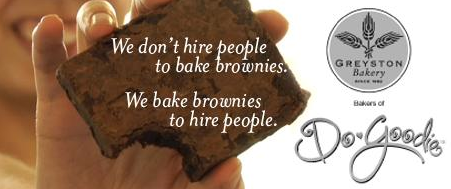Click the player to listen to the interview or right-click and save to download the MP3.
What do world-class brownies and hard-to-hire employees have in common? A bakery called Greyston.
Greyston Bakery founder and Zen Buddhist teacher Bernie Glassman started with a social mission and built a profitable business around it. To carry out his mission–providing jobs, training and income to low- or non-skilled workers–Bernie needed a business plan. For most of us, it’s the opposite; we start with a business (plan) and then look for a social mission that resonates. We are well trained to think about revenue models, but what about social mission models? What successful models can we draw from and what can we learn from other companies?

I invited Jonathan Greengrass to Cause Capitalism to talk about the function and benefits of Greyston’s model of social enterprise. Jonathan is the Vice President of Development and Public Relations for the Greyston Foundation, the non-profit entity that owns the for-profit bakery–a unique set-up in itself. One-hundred percent of bakery profits are given to the foundation to create affordable housing, daycare, HIV/AIDS treatment and training programs.
Since its founding in 1982, Greyston Bakery has shaped its reputation on providing the brownie bits for Ben & Jerry’s ice cream, as well as cakes for Bloomingdale’s and the White House. Fifty-five employees (many of whom were on welfare or had been incarcerated) now earn an income and receive training and support while they bake brownies and gluten-free products out of a facility in Yonkers, NY.
I highlighted some key points from the conversation below.
- “We don’t hire people to bake brownies. We bake brownies to hire people,” goes Greyston’s tag line. The brownies they bake also subsidize more than 200 units of long-term affordable housing, a certified daycare center and an adult day program and housing for individuals living with HIV/AIDS.
- The bakery uses 100% organic and natural ingredients and buys locally when there is adequate supply.
- Greyston has an “Open Hiring” policy which means that anyone who wants a job can work at the bakery when a position opens up. There are no interviews, applications or background checks. “We’re the employer of second, third and fourth chances,” says Jonathan. He stresses, however, that Greyston is for people who want to work. It’s not a rehabilitation or social service program, it’s a business. Employees do receive job training and support for issues they may face personally, but the distinction is clear. Greyston is a business with clear documentation, metrics and monitoring.
- All employees go through a one-year apprenticeship program during which they receive weekly training sessions, can participate in peer support groups and learn skills like resume writing and financial literacy. Graduates of the apprenticeship get a cash stipend for completing the program, become fully unionized, receive full benefits and are eligible for employee bonuses.
- Greyston’s finances are completely transparent. Any employee can see how the bakery is doing and gauge his own performance.
- The average employee works with Greyston for 4-5 years. Past employees have moved on to start their own businesses.
- For the past couple of years, the bakery has broken even. With its new line of gluten-free products and Do-Goodie retail brownies, they anticipate turning a profit again in the next year or two. During this time, hundreds of people have received living wages, a stable job and training.
- A large portion of Greyston’s business comes from online sales of corporate gifts and it’s gluten-free line.
- The foundation is in the process of launching a new social enterprise, which has two essential criteria: to provide jobs for the hard-to-employ and to become profitable in 3-4 years. A year ago, the foundation held a large brainstorming session with community leaders and residents, bakery employees and volunteers. They’ve narrowed down the ideas to two concepts and are now doing significant feasibility studies on both. If either is feasible, the board of directors will approve it and then the foundation will write a business plan. The only difference between launching a “new enterprise that fits our criteria and launching a new business, is that our employees come to us with little or no job skills,” says Jonathan.
- Whether the new business will be a for-profit or non-profit will depend on the function of the business, attitudes of its employees and tax considerations.





 I'm Olivia Khalili. I created Cause Capitalism to show you how to grow your business by incorporating a social mission.
I'm Olivia Khalili. I created Cause Capitalism to show you how to grow your business by incorporating a social mission. 

Trackbacks/Pingbacks
[…] Hybrid Nonprofit Ventures (Model 2) serve “populations that have been excluded or underserved by mainstream markets.” Making a profit is possible, but the organization isn’t predicated on it. The enterprise recovers some of its costs by selling a product or service.  One example is Greyston Bakery. […]
[…] As we have stretched and pulled the cafe into shape, I realize in some ways, to borrow an idea from Jonathan Greengrass, we have not hired women to make salads, rather we make salads to train women. But, in the […]